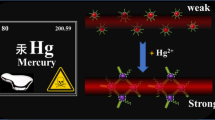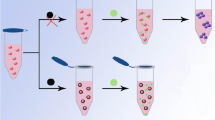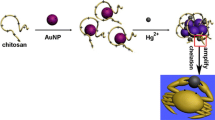Abstract
As mercury ions (Hg2+) are emanated to surroundings in the course of various natural events and human activities, an accurate sensing of Hg2+ is essential for human health and environmental protection. Herein, a new aggregation-induced chemiluminescence (CL) sensor for fast, sensitive, and selective detection of Hg2+ is developed, based on the CL enhancement of bis(2,4,6-trichlorophenyl)oxalate (TCPO)-H2O2 system by thiolate-protected gold complexes (Au(I)-thiolate complexes) in the aggregated state. Because Hg2+ has a strong interaction with hydrosulfuryl (-SH) groups in Au(I)-thiolate complexes, the aggregation is disrupted and the CL is quenched. The decrease of CL intensity is proportional to Hg2+ contents with a linear range of 0.005–10 μg mL−1 and the limit of detection (LOD) is 3 ng mL−1. To the best of our knowledge, this is the first AIE CL sensor for Hg2+ detection. The study opens up attractive perspectives for developing simple and rapid aggregation-induced CL methods in monitoring heavy metals.






Similar content being viewed by others
References
Wu QR, Li GL, Wang SX, Liu KY, Hao JM. Mitigation options of atmospheric Hg emissions in China. Environ Sci Technol. 2018;52:12368–75.
EPA. Mercury update: impact on fish advisories, Office of Water: Washington, DC 2001;Fact Sheet:EPA-823-F-01-011.
Pirrone N, Mahaffey KR. Dynamics of mercury pollution on regional and global scales: atmospheric processes and human exposures around the world; mercury update: impact of fish advisories. New York: Springer;2005.
Shamsipur M, Rajabi HR, Beyzavi MH, Sharghi H. Bulk polymer nanoparticles containing a tetrakis(3-hydroxyphenyl)porphyrin for fast and highly selective separation of mercury ions. Microchim Acta. 2013;180:791–9.
Rofouei MK, Sabouri A, Ahmadalinezhad A, Ferdowsi H. Solid phase extraction of ultra traces mercury (II) using octadecyl silica membrane disks modified by 1,3-bis(2-ethoxyphenyl)triazene (EPT) ligand and determination by cold vapor atomic absorption spectrometry. J Hazard Mater. 2011;192:1358–63.
Wang H, Wu ZK, Chen BB, He M, Hu B. Chip-based array magnetic solid phase microextraction on-line coupled with inductively coupled plasma mass spectrometry for the determination of trace heavy metals in cells. Analyst. 2015;140:5619–26.
Rastogi L, Krishna MVB, Chandrasekaran K, Karunasagar D. A novel Cu-BSA nanocomposite based vapour generation approach for the rapid determination of mercury in aqueous media by cold vapour atomic absorption spectrometry and on-line flow injection inductively coupled plasma mass spectrometry. J Anal Atom Spectrom. 2014;29:721–9.
Rajabi HR, Roushani M, Shamsipur M. Development of a highly selective voltammetric sensor for nanomolar detection of mercury ions using glassy carbon electrode modified with a novel ion imprinted polymeric nanobeads and multi-wall carbon nanotubes. J Electroanal Chem. 2013;693:16–22.
Rajabi HR, Shamsipur M, Zahedi MM, Roushani M. On-line flow injection solid phase extraction using imprinted polymeric nanobeads for the preconcentration and determination of mercury ions. Chem Eng J. 2015;259:330–7.
Wang Z, Yang M, Chen C, Zhang L, Zeng H. Selectable ultrasensitive detection of Hg2+ with rhodamine 6G-modified nanoporous gold optical sensor. Sci Rep. 2016;6:29611.
Juskowiak B. Nucleic acid-based fluorescent probes and their analytical potential. Anal Bioanal Chem. 2011;399:3157–76.
Hu RR, Leung NLC, Tang BZ. AIE macromolecules: syntheses, structures and functionalities. Chem Soc Rev. 2014;43:4494–562.
Yu L, Chen HX, Yue J, Chen XF, Sun MT, Tan H, et al. Metal−organic framework enhances aggregation-induced fluorescence of chlortetracycline and the application for detection. Anal Chem. 2019;91:5913–21.
Yan L, Wen XY, Fan ZF. A large-Stokes-shift fluorescent probe for Zn2+ based on AIE, and application in live cell imaging. Anal Bioanal Chem. 2020;412:1453–63.
Yuan YL, Chen X, Chen Q, Jiang GY, Wang HM, Wang JG. New switch on fluorescent probe with AIE characteristics for selective and reversible detection of mercury ion in aqueous solution. Anal Biochem. 2019;585:113403.
Xu Y, Li H, Wang B, Liu HC, Zhao L, Zhou TY, et al. Microwave-assisted synthesis of carbon dots for “turn-on” fluorometric determination of Hg(II) via aggregation-induced emission. Microchim Acta. 2018;185:252–9.
Sun XH, Shi W, Ma FD, Hui YH, Xu LX, Mi HY, et al. Thymine-covalently decorated, AIEE-type conjugated polymer as fluorescence turn-on probe for aqueous Hg2+. Sens Actuator B-Chem. 2014;198:395–401.
Chen YC, Zhang WJ, Cai YJ, Kwok RTK, Hu YB, Lam JWY, et al. AIEgens for dark through-bond energy transfer: design, synthesis, theoretical study and application in ratiometric Hg2+ sensing. Chem Sci. 2017;8:2047–55.
Zhu J, Zhao BZ, Qi Y, Li JJ, Li X, Zhao JW. Colorimetric determination of Hg(II) by combining the etching and aggregation effect of cysteine-modified Au-Ag core-shell nanorods. Sens Actuator B-Chem. 2018;255:2927–35.
Gao BJ, Haghighatbin MA, Cui H. Polymer-encapsulated cobalt/gold bimetallic nanoclusters as stimuli-responsive chemiluminescent nanoprobes for reactive oxygen species. Anal Chem. 2020;92:10677–85.
Gnaim S, Scomparin A, Das S, Blau R, Satchi-Fainaro R, Shabat D. Direct real-time monitoring of prodrug activation by chemiluminescence. Angew Chem Int Edit. 2018;57:9033–7.
Bodulev OL, Burkin KM, Efremov EE, Sakharov IY. One-pot microplate-based chemiluminescent assay coupled with catalytic hairpin assembly amplification for DNA detection. Anal Bioanal Chem. 2020;412:5105–11.
Sun Y, Xu XT, Zhao YX, Tan HN, Li YH, Du JX. Luminescent metal organic frameworks-based chemiluminescence resonance energy transfer platform for turn-on detection of fluoride ion. Talanta. 2020;209:120582.
Luo ZT, Yuan X, Yu Y, Zhang QB, Leong DT, Lee JY, et al. From aggregation-induced emission of au(I)-Thiolate complexes to ultrabright Au(0)@Au(I)-Thiolate core-shell Nanoclusters. J Am Chem Soc. 2012;134:16662–70.
Halawa MI, Lai J, Xu G. Gold nanoclusters: synthetic strategies and recent advances in fluorescent sensing. Mater Today Nano. 2018;3:9–27.
Zhu LP, Ye J, Yan MX, Zhu QJ, Wang S, Huang JS, et al. Electrochemiluminescence immunosensor based on Au nanocluster and hybridization chain reaction signal amplification for ultrasensitive detection of cardiac troponin I. ACS Sens. 2019;4:2778–85.
Zhang LJ, He N, Lu C. Aggregation-induced emission: a simple strategy to improve chemiluminescence resonance energy transfer. Anal Chem. 2015;87:1351–7.
Zhou C, Sun C, Yu MX, Qin YP, Wang JG, Kim M, et al. Luminescent gold nanoparticles with mixed valence states generated from dissociation of polymeric Au(I) thiolates. J Phys Chem C. 2010;114:7727–32.
Hang A, Hui F, Li KQ, Zhao MZ, Qian ZS, Chen JR. Coordinate bonding-induced emission of gold-glutathione complex for sensitive detection of aluminum species. Sens Actuator B-Chem. 2018;272:1–7.
Ding WC, Liu Y, Li YJ, Shi QR, Li HS, Xia HB, et al. Water-soluble gold nanoclusters with pH-dependent fluorescence and high colloidal stability over a wide pH range via co-reduction of glutathione and citrate. RSC Adv. 2014;4:22651–9.
Jia XF, Li J, Wang EK. Cu nanoclusters with aggregation induced emission enhancement. Small. 2013;9:3873–9.
Qu F, Zhao LY, Han WL, You JM. Ratiometric detection of Zn2+ and Cd2+ based on self-assembled nanoarchitectures with dual emissions involving aggregation enhanced emission (AEE) and its application. J Mater Chem B. 2018;6:4995–5002.
He T, Qi L, Zhang J, Huang YL, Zhang ZQ. Enhanced graphene quantum dot fluorescence nanosensor for highly sensitive acetylcholinesterase assay and inhibitor screening. Sens Actuator B-Chem. 2015;215:24–9.
Negishi Y, Nobusada K, Tsukuda T. Glutathione-protected gold clusters revisited: bridging the gap between gold(I)−thiolate complexes and thiolate-protected gold nanocrystals. J Am Chem Soc. 2005;127:5261–70.
Liu XQ, Shu X, Zhou X, Zhang X, Zhu J. Ultra-sensitive fluorescent sensor for Hg2+ based on a donor-acceptor-donor framework. J Phys Chem A. 2010;114:13370–5.
Funding
This work received funding from Shaanxi Provincial Natural Science Foundation of China (No. 2018JM2002). This work also received support from the Fundamental Research Funds for the Central Universities (No. GK201902009, No. GK201701002) and Program for Innovative Research Team in Shaanxi Province (No. 2014KCT-28).
Author information
Authors and Affiliations
Corresponding author
Ethics declarations
Conflict of interest
The authors declare that they have no conflicts of interest.
Additional information
Publisher’s note
Springer Nature remains neutral with regard to jurisdictional claims in published maps and institutional affiliations.
Supplementary Information
ESM 1
(PDF 102 kb)
Rights and permissions
About this article
Cite this article
Hou, Y., Chen, Y., Guo, X. et al. Aggregation-induced chemiluminescence system for sensitive detection of mercury ions. Anal Bioanal Chem 413, 625–633 (2021). https://doi.org/10.1007/s00216-020-03033-5
Received:
Revised:
Accepted:
Published:
Issue Date:
DOI: https://doi.org/10.1007/s00216-020-03033-5




